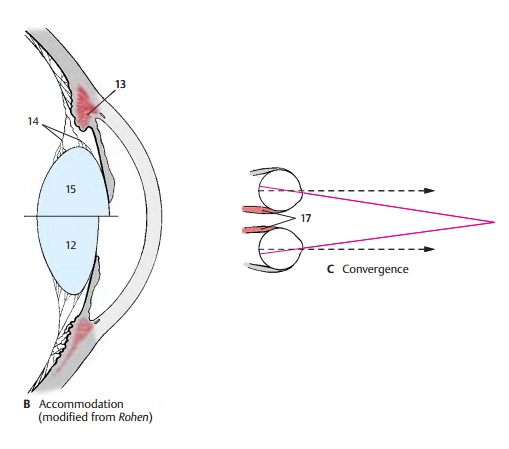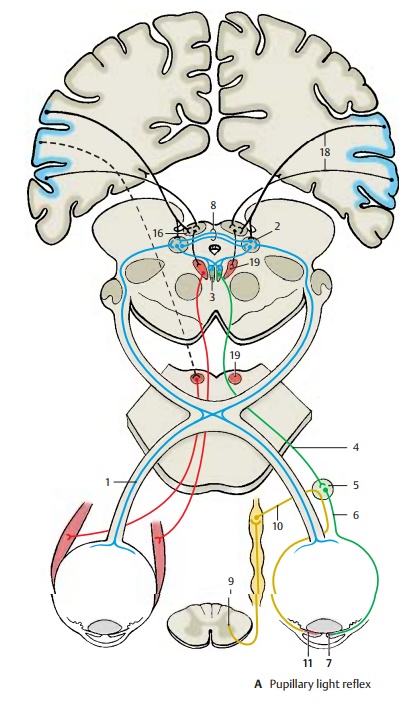Chapter: Human Nervous System and Sensory Organs : The Eye
Ocular Reflexes - Eye

Ocular Reflexes
During the visual process the eye must con-tinuously compensate for changes from light to dark and from near to far. Both the aperture and lens system must continuously adapt to the prevailing conditions. Whereas light–dark adaptation is achieved by dilatation or contraction of the pupil,near–far adaptation requires a change in the curva-ture of the lens (accommodation), a change in the lines of sight (convergence), and a change in pupillary width. During negativeaccommodation (adjustment for long dis-tances), the surface of the lens is only slightly curved, the lines of sight run paral-lel, and the pupils are dilated. During posi-tive accommodation (adjustment for shortdistances), the surface of the lens is dis-tinctly curved, the lines of sight cross at a distance that corresponds to the fixated ob-ject, and the pupils are constricted.
Pupillary Light Reflex (A)
When light falls onto the retina, the pupil constricts. The afferent loop of this reflex arch is formed by optic nerve fibers (A1) ex-tending to the pretectal nucleus (A2). The latter is connected with the rostral part of the Edinger – Westphal nucleus (accessory oculomotor nucleus) (A3), the fibers of which (A4) extend as the efferent limb of the reflex arch to the ciliary ganglion (A5). The postganglionic fibers (A6) in-nervate the sphincter muscle of the pupil (A7). Both pretectal nuclei are connected via the epithalamic commissure (A8). In addi-tion, the optic nerve fibers of each side ter-minate in the two pretectal nuclei. This ex-plains the bilaterality of the light reflex; when light falls only onto one eye, the pupil of the other eye constricts as well (consen-sual pupillary response). Ciliospinal center(A9); sympathetic fibers (A10) for the di-lator of the pupil (A11).

Accommodation (B)
The accommodation apparatus consists of the lens, its suspension mechanism (ciliary zone), the ciliary body, and the choroidea. These parts form a tense, elastic systemwhich spans the entire eyeball and main-tains the flat, slightly curved form of the lens (B12) (negative accommodation). Duringpositive accommodation the circular ciliarymuscle (B13) contracts. The meridional muscle fibers pull the origins of the long zonular fibers forward, and the circular fibers move the ciliary processes closer to the margin of the lens. This relaxes both the zonular fibers (B14), and the lens capsule, thus causing the lens to round off (B15).
The fiber tracts of the accommodation reflex are less well known. As fixation of an object is the prerequisite of accommodation, the optic nerve is theafferent loop. The reflex arch runs propably via the visual cortex (striate area) to the pretectal nuclei, possibly also via the superior colliculi (A16). Theefferent loop begins in the caudal part of the Edinger – Westphal nucleus. Its fibers synapse in the ciliary ganglion with post-ganglionic fibers that innervate the ciliary muscle.

Convergence (A, C)
When an object approaching from a far dis-tance is fixated with both eyes, the medial rectus muscles (C17) increasingly adduct both eyeballs, and the lines of sight which initially run parallel (broken arrows) begin to cross each other. The fixated object re-mains in the intersection of the lines of sight while being projected onto each macula.
The visual fixation reflex probably runs via the visual pathway to the occipital cortex and via the corticofugal fibers (A18) to the supe-riorcolliculi, to the pretectal region, and to the nuclei of the ocular muscles (A19). The occipital cortex is therefore regarded as a reflex center (occipital eye fields).
Related Topics